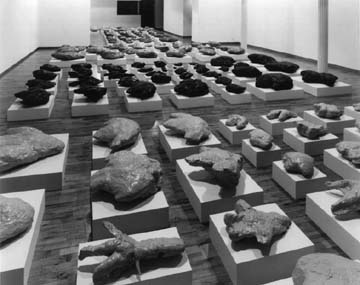 Artist Allan McCollum's
latest exhibit features
casts of dinosaur tracks
uncovered at underground
coal mining operations
in Carbon and Emery
counties.
Artist Allan McCollum's
latest exhibit features
casts of dinosaur tracks
uncovered at underground
coal mining operations
in Carbon and Emery
counties.
Artist Allan McCollum's latest exhibit, entitled "Natural Copies from the
Coal Mines of Central Utah," features casts of dinosaur tracks found in
the roofs of coal mines in central Utah. McCollum discovered a collection
of over 40 of the fossils on display at the College of Eastern Utah
Prehistoric Museum.
The tracks were discovered by local coal miners, carefully excavated from
freshly discovered locations and then donated to the museum. The
museum allowed McCollum to have rubber molds made from the tracks
and the molds were moved to New York in 1994. New production molds
were made from the originals and natural copies for the exhibit were
produced in early 1995.
The tracks were created by a series of prehistoric circumstances.
First, the dinosaurs walked over spongy beds of decaying vegetation and
the footprints were filled with sand. Thousands of feet of additional
sediment were deposited on the tracks, which compressed the peat to form
coal and solidified the sand to sandstone. Mining activities left the tracks
protruding downward into the shafts and the tracks were discovered when
the residual coal was removed, exposing the white sandstone filling the
original tracks.
|
|
In addition to the "Natural Copies" exhibit a series of essays and articles
from popular and scientific sources on the history and significance of the
dinosaur track natural cast phenomena, researched and compiled by the
artist, are also presented in the gallery in the form of photocopies available
free to the visitors.
"The hundreds of natural copies in Allan McCollum's present exhibit
might be seen as simply the most recent chapter in a narrative which
stretches from prehistoric times to the present and recounts the different
incarnations of an unusual kind of trace fossil," pointed out a press
release issued by the museum. "The original 65-million-year-old casts,
discovered since the 1920s by coal miners working in central Utah, are
clearly artifacts in a story of natural history. But this narrative intersects
with another one, the local history of a particular community.
The footprints, found by workers in the roofs of coal mines, valued as
objects of curiosity or aesthetic beauty, were additionally understood as
specimens of some scienific merit and were sold or donated to the local
paleontology museum by their original owners. This suggests a complex
network of related stories involving community relations and
museological practices."
"By reproducing the natural casts as artwork, McCollum intersects
another narrative into the story," explained the press release. "Originally
discovered in the roofs of underground coal mines, the footprints' inverted
position offers the eerie experience of a dinosaur walking on the ground
above one's head, already suggesting the realm of the fantastic: monsters
and exotic creatures from a primeval and forgotten past, treasures
produced over the millennia and unearthed from the subterranean depths
through the competitive and determined search for the `rock that burns'".
The dinosaur tracks will be on display until April 22.
|
 Artist Allan McCollum's
latest exhibit features
casts of dinosaur tracks
uncovered at underground
coal mining operations
in Carbon and Emery
counties.
Artist Allan McCollum's
latest exhibit features
casts of dinosaur tracks
uncovered at underground
coal mining operations
in Carbon and Emery
counties.